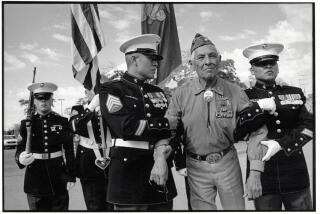Seeds of a life
CYNTHIA KADOHATA ranks high on my list of Los Angeles writers whose books I put in people’s hands with the words, “Read this. You’ll love it. It deserves to be much better known.” Kadohata writes beautifully and penetratingly about life on the margins of society and about the in-betweenness of immigrant life. It is tempting to say, now that she is writing for children, that she has found her metier. After all, her first such novel, “Kira-Kira,” won last year’s Newbery Medal, the highest honor in children’s fiction. The fact is, however, that she has practiced her metier with great elegance since the beginning; now that she has begun writing for young readers, she has at last found an audience that deserves her.
In her first book, “The Floating World” (1989), and in “Kira-Kira,” Kadohata wrote about Japanese American families eking out a living in the face of pervasive racism. Her characters carefully stick to the small island of family out of cultural inclination -- their loyalties to each other are very strong -- as well as because they are not welcome in the neighborhood. The family, for them, is the only safe ground. In her new novel, “Weedflower,” Kadohata adds a more overtly political dimension by setting her story during World War II, when Americans of Japanese descent were interned by the U.S. government.
Twelve-year-old Sumiko, the daughter of California flower farmers, is the only Japanese student at her school. She has never had a friend among the white students, but when her class is invited to a girl’s birthday party, she feels that her position is about to change. As she carefully selects her dress and cuts flowers to bring as a gift, she speculates on pleasant things that may happen at the party; perhaps they will even ask her to sing. Sumiko’s touching naivete about what she hopes for from the other children captures precisely the gap between those who belong and those on the outside.
The date on the party invitation -- Saturday, Dec. 6, 1941 -- will signal to any reader who has committed a few historical dates to memory that this is not a propitious moment to make friends. Sumiko is turned away at the door; the next day, Pearl Harbor is bombed.
Life in wartime is an excellent subject for young adult fiction, because it throws into violent relief the inescapable fact -- as well as a basic lesson of growing up -- that every human being, from the most authoritative grown-up to the tiniest child, is equally powerless to predict, much less control, what may happen. The U.S. declaration of war against Japan sends Sumiko’s world into disarray. Japanese American families are in limbo: Banks freeze their funds, business comes to a halt, the children stay home from school. Rumors fly. Elders sit in their living rooms, dressed for travel with bags packed, waiting to be arrested.
Although the subject matter of “Weedflower” may sound grim, the reader’s attention is drawn to Sumiko’s compelling inner life rather than the circumstances. She is no victim. When the train carrying the Japanese Americans arrives in the desert town near their detention camp, the local people come out to watch them being transferred from the train to buses. “The staring made Sumiko feel haji [shame], as if she’d done something wrong, but also a little anger, because she knew she hadn’t done anything wrong. She knew -- because [her grandfather] had once told her so -- that the haji she felt was from her Japanese side and the anger she felt was from her American side.”
Life in camp quickly deteriorates. The children, raised with strict rules about obedience to parents, run wild in packs, fight, steal food and worse. Adults without occupation lie for days on end in their bunks; young men gamble away the scandalously little money their families received from the forced sale of their possessions.
Sumiko feels the danger of what her grandfather called “the ultimate boredom” -- the madness that comes when there is no reason to go on. She feels her vision of adult life slipping away -- she has always hoped to run a flower shop -- as she reckons how old she may be when the war ends and what freedom may mean after such senseless imprisonment.
The senselessness of the imprisonment takes on a more subtle shading when Sumiko realizes that the camp is on an Indian reservation. The internees are deeply mistrustful of the Indians (the children, of course, exchange frightening stories about their bloodthirstiness). The Indians, for their part, resent the Japanese presence and recognize an irony: The amenities provided for the Japanese will only improve the reservation when the Japanese are finally gone.
When Sumiko befriends an Indian boy, Frank, she discovers that even friendship, which she has been thirsting for, is not as straightforward as it seems. The internees’ prejudice against the Indians means she will have to hide the friendship or stand up for it.
Sumiko’s independence of mind enables Kadohata to make her story not just an indictment of the internment but an examination of what makes life worth living even under dreadful circumstances. Making sense of life -- finding true friends and cultivating work that has value -- is what staves off “the ultimate boredom.” The camp experience may have temporarily stripped Sumiko of her dream of running a flower shop, but the knowledge she has gained of what is worth clinging to will carry her to adulthood. It is this ability to bring a specific story to life while also commenting on the timeless, universal problems of human existence that is the hallmark of good literature. And that applies no less to children’s literature than it does to grown-up books. *
More to Read
Sign up for our Book Club newsletter
Get the latest news, events and more from the Los Angeles Times Book Club, and help us get L.A. reading and talking.
You may occasionally receive promotional content from the Los Angeles Times.






